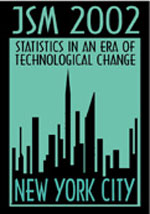|
Activity Number:
|
321
|
|
Type:
|
Contributed
|
|
Date/Time:
|
Wednesday, August 14, 2002 : 12:00 PM to 1:50 PM
|
|
Sponsor:
|
Section on Physical & Engineering Sciences*
|
| Abstract - #301103 |
|
Title:
|
Modeling Performance of Engineering Controls When Reductions Are Largest at the Highest Environmental Concentrations of the Hazardous Contaminant
|
|
Author(s):
|
Stanley Shulman*+ and Kenneth Mead and Leroy Mickelsen
|
|
Affiliation(s):
|
National Institute for Occupational Safety and Health and National Institute for Occupational Safety and Health and National Institute for Occupational Safety and Health
|
|
Address:
|
4676 Columbia Parkway, MS- R3 , Cincinnati, Ohio, 45226, USA
|
|
Keywords:
|
Randomized Blocks ; Interaction ; Environmental Effects
|
|
Abstract:
|
Engineering controls are often compared outdoors using randomized pairs to determine if a new control design reduces worker exposure to airborne hazardous contaminants--when compared to an uncontrolled work environment. A common occurrence is that the ratio of means (of controlled-to-uncontrolled work environments) depends upon concentration. When the uncontrolled environment is at its highest concentrations, the engineering control has greatest impact and the ratio is smallest (reduction is largest). Such interaction may arise outdoors because of wind and other natural conditions that vary contaminant concentrations. The following approaches to model this interaction are compared: a.) model estimates reduction separately for upper 25% of uncontrolled samples and for lower 75%; b.) model -based on Tukey's one degree of freedom model for interaction; c.) model generalizes Tukey's model. The ability of the approaches to model the interaction is compared.
|

